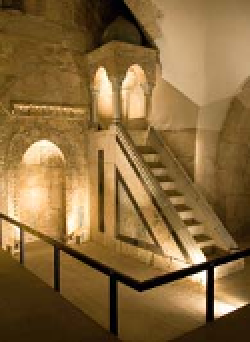Travel Reference
In-Depth Information
LATE ROMAN AND
BYZANTINE PERIODS
A small room in thA Southeast
Tower deals with the creation
of Aelia Capitolina, the Roman
city, built on the ruins of
Second Temple-era Jerusalem.
The room has floors based on
mosaics from Hadrian's Villa
in Rome and the St Martyrius
Monastery near Jerusalem.
There is also a splendid
model, 1.5 m (5 ft) long,
of the Church of the Holy
Sepulchre as it is thought to
have looked when it was first
built in the 4th century, on
the orders of Helena, mother
of the Emperor Constantine.
The sabil of Suleyman in a finely detailed model in the Ottoman room
the room shows that by this
time the Old City had taken
on the form in which it
appears today. There is also
a model of the Crusader
Church of St Anne's and life-
size statues of the Western
knights, as well as a brightly
coloured diorama depicting
the famed conqueror of the
Crusaders, Saladin (Salah ed-
Din in Arabic), in his tent
outside the city walls.
END OF THE OTTOMANS
AND THE BRITISH
MANDATE
This last room is a brief race
through the last century and
a quarter of the city's history.
The story it tells is of the
mass influx of Christian
pilgrims and Jewish immi-
grants who began to settle
for the first time outside the
security of the walls of the
Old City and, in doing so,
established what is now the
modern city of Jerusalem. In
addition to the photos and
illustrations is some rare 1896
Lumière Brothers footage of
the Jerusalem-- affa railway.
The chronological sequence
ends in a separate hall with
a vast and superb model of
Jerusalem as it was at the
time, made by a Hungarian
artist in 1873. It was exhibited
throughout Europe before
going into storage and being
forgotten for a century until
its rediscovery and removal
here in the early 1980s.
THE MAMELUKES AND
OTTOMANS
The final exhibition rooms
are housed in the large,
northwest tower. The
Mamelukes (1260-1516), a
dynasty of former slaves who
ruled from Egypt, endowed
Jerusalem with some of its
most distinctive and beautiful
buildings. Their contribution
is represented by drawings
and a scale reconstruction of
a street of distinctive
striped-stone
(ablaq)
architecture. You
Y
can see similar
examples today
at Lady Tunshuq's
Palace in the Old
City
(see p65
y .
Illustrating
Ottoman
Jerusalem
is a large-
scale model
of a fountain
(sabil)
erected
by Suleyman the
Magnificent - the
real thing survives
today on Chain
Street in the
Muslim Quarter.
The prayer niche and pulpit in the
Citadel's former mosque
EARLY ISLAM AND THE
CRUSADES
Appropriately enough, the
early Islamic exhibits are
housed in the
Citadel's former
mosque. This is
the most striking
room in the whole
Citadel complex,
with a still intact
mihrab
(niche
b
indicating the
direction of Mecca)
and
minbar
(pulpit).
r
At the centre of
the room is a
large, detailed,
sectioned model
of the Dome of
the Rock. The
model apparently
took two years to
construct. A pewter
A
model at the centre of
Detail of the enormous model of
Jerusalem constructed in 1873
Members of
Saladin's retinue




















